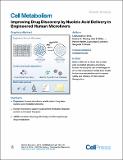Improving Drug Discovery by Nucleic Acid Delivery in Engineered Human Microlivers
Author(s)
Mancio Silva, Liliana; Fleming, Heather; Miller, Alex B; Milstein, Stuart; Liebow, Abigail; Haslett, Patrick; Sepp-Lorenzino, Laura; Bhatia, Sangeeta N; ... Show more Show less
DownloadPublished version (2.290Mb)
Terms of use
Metadata
Show full item recordAbstract
The liver plays a central role in metabolism; however, xenobiotic metabolism variations between human hepatocytes and those in model organisms create challenges in establishing functional test beds to detect the potential drug toxicity and efficacy of candidate small molecules. In the emerging areas of RNA interference, viral gene therapy, and genome editing, more robust, long-lasting, and predictive human liver models may accelerate progress. Here, we apply a new modality to a previously established, functionally stable, multi-well bioengineered microliver—fabricated from primary human hepatocytes and supportive stromal cells—in order to advance both small molecule and nucleic acid therapeutic pipelines. Specifically, we achieve robust and durable gene silencing in vitro to tune the human metabolism of small molecules, and demonstrate its capacity to query the potential efficacy and/or toxicity of candidate therapeutics. Additionally, we apply this engineered platform to test siRNAs designed to target hepatocytes and impact human liver genetic and infectious diseases. Mancio-Silva et al. show that nucleic acid-mediated silencing of primary human hepatocytes can be leveraged in an in vitro engineered human liver model to fine-tune metabolism and to assess safety and efficacy of RNAi-based therapeutics.
Date issued
2019-03Department
Massachusetts Institute of Technology. Institute for Medical Engineering & Science; Koch Institute for Integrative Cancer Research at MITJournal
Cell Metabolism
Publisher
Elsevier BV
Citation
Mancio Silva, Liliana et al. "Improving Drug Discovery by Nucleic Acid Delivery in Engineered Human Microlivers." Cell Metabolism 29, 3 (March 2019): P727-735.e3 © 2019 The Authors
Version: Final published version
ISSN
1550-4131